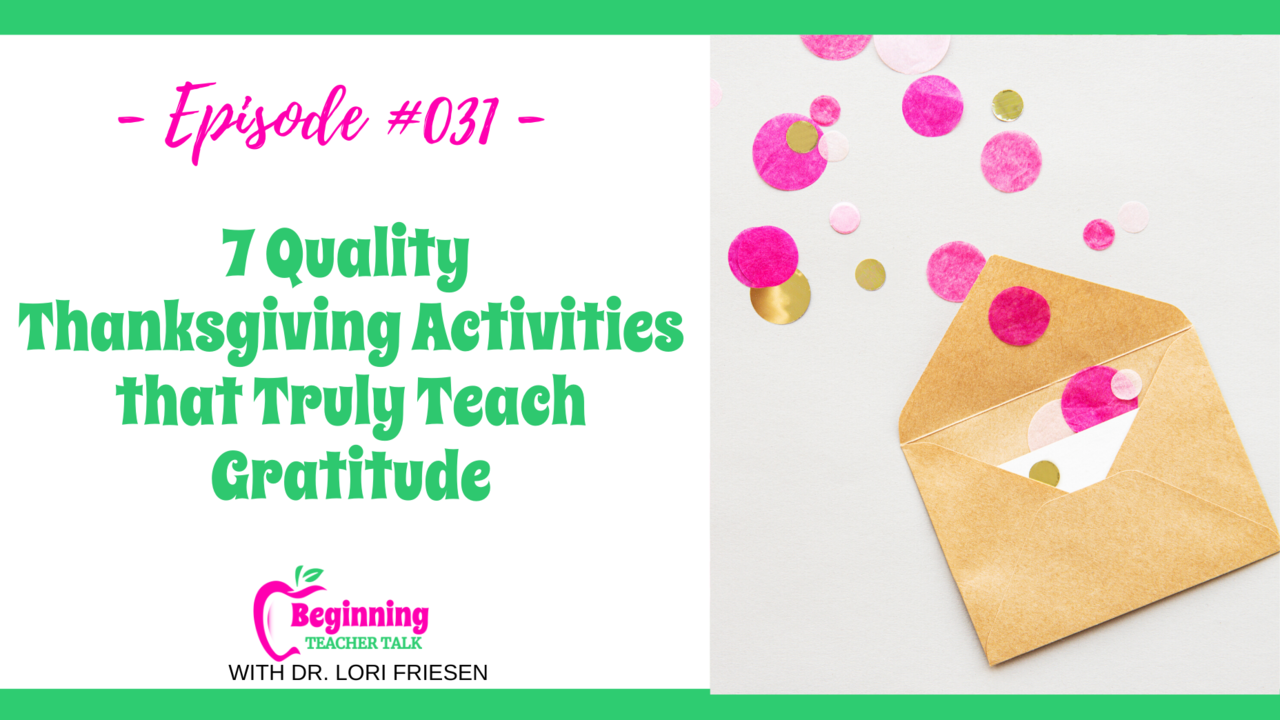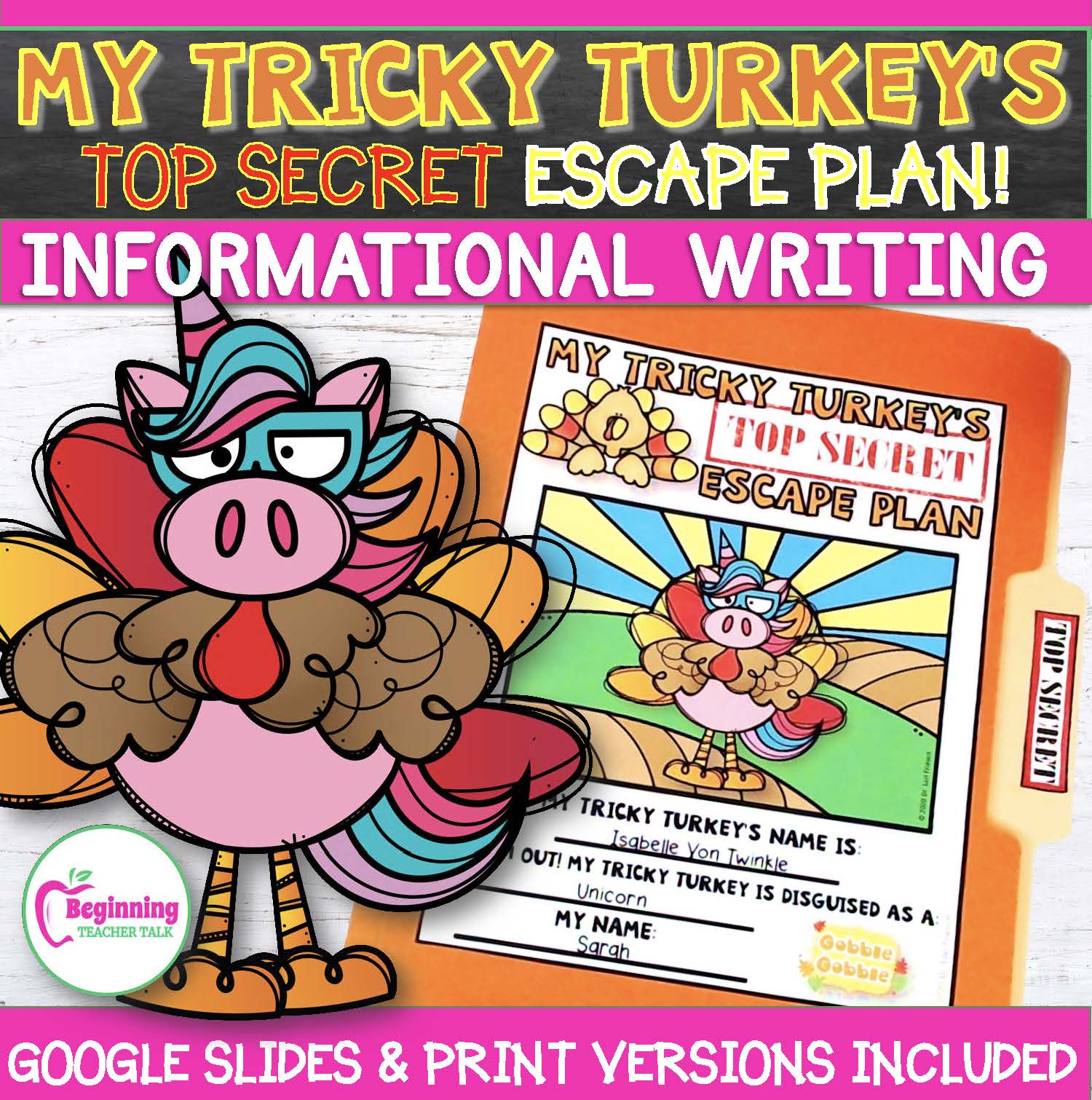7 Quality Thanksgiving Activities that Truly Teach Gratitude

Click the play bar below to listen to this episode now:
Show Notes:
Sometimes I think the meaning of Thanksgiving can get lost in a sea of turkey craft projects, so today, I wanted to give you seven ideas for truly meaningful Thanksgiving activities you can do with your students to teach gratitude, not only during this season, but these are ideas that you an infuse into your practice – both at home and at school – throughout the year.
You might be wondering - is gratitude really that important when it comes to student learning?
Well, it turns out that the answer is yes.
Research has shown that children who cultivate a genuine attitude of gratitude enjoy greater life satisfaction, better attitudes about school and increased levels of self-esteem, hope, empathy, and optimism.
Also, gratitude can help children to gain a more balanced perspective about all of the blessings they already have in their lives.
So, let’s talk about seven meaningful and quality ways that we can cultivate an attitude of gratitude in our own classrooms – not just on Thanksgiving, but throughout the year, so our students can enjoy some of these incredibly powerful and positive benefits.
-
Be Your Students’ Model:
Start each day by sharing 3 things YOU are grateful for, and then ask your students to share 3-5 things that they are grateful for.
You could also decide to design your students’ morning work to list three things that they are grateful for. In fact, one study demonstrated that when students wrote five things they were grateful for every day for two weeks, they not only enjoyed a more positive outlook on school specifically, but they benefited from increased life satisfaction in general.
Those sound like pretty good reasons to engage in daily habits of gratitude to me! So again, start the day by modeling this for your students by sharing three things YOU are grateful for each morning, and then ask your students to share some of the things they have written down about what they are grateful for.
-
Re-Imagine Familiar Routines:
Instead of spending your time saying things like “No talking!” when kids are standing in line waiting to leave for the day, change the energy of this experience and make it a habit, when children, are lined up, to take turns naming something they are grateful for (no repeats). -
Reward Hard Work with Genuine and Specific Praise:
Show you are grateful for your students' hard work and good behavior not with material possessions, but with genuine and specific praise for what you appreciate about them.
For example, when students clean up their work space well without needing to be reminded, tell them,
"I am so proud of you for picking up all of the trash and putting away the glue and the scissors without even being reminded. Thank you for being so thoughtful and considerate!"
Tell your students why you are grateful for them, and be specific.
Ask the question, "Do you know why I am so grateful for you? It's because you...."
Just watch your students' faces light up when they know that you're proud of them and grateful for them.
-
Do a Gratitude Walk with Your Students:
I never thought I wanted to live in Kentucky.
However, we have created such a beautiful home and such a peaceful space here that I wake up each morning, and as I walk to the kitchen to get my coffee, I am flooded with gratitude that I get to call this incredible place my home.
In the summer months, my back yard and my garden is magnificent, all of the animals that come to visit, the little waterfall that my son and my husband created with their own two hands, the flowers and the peace, and I can’t tell you how grateful I am to just sit in that space and soak in every single minute of it.
I am absolutely convinced that the more grateful we are for what we have, the more abundance of good things will continue to flow into our lives.
One of the best ways to help our students to begin to experience the peace and the joy that comes with appreciating what is and what they already have is with what I call a gratitude walk.
The point of a gratitude walk is to walk around without speaking, and pay attention to everything around you that you are grateful for.
With kids, it’s sometimes helpful to keep them present and focused if you ask them to either draw pictures of or write a list of 5 or 10 or 20 things they experience around them that they are grateful for.
If it’s warm enough where you are, it’s great to take kids outside to do this exercise, and the point is to become present to everything around them that they feel gratitude for.
-
Create Something Amazing for Your School Secretary or Custodian:
Few things help children to express gratitude more than engaging them in activities that give them opportunities to co-create meaningful experiences.
Creating something amazing for the school secretary or custodian can be a wonderful experience for children, especially because they are usually in the position of being cared-for, rather than being the one in charge, who gets to care for others.
Engage your students in a conversation about who they are especially grateful for at your school, such as your school secretary or your custodian, your school librarian, or maybe even the principal, and then think of ways that they can express that gratitude for those specific individuals.
Maybe this means writing thank you cards for those individuals and hand delivering them with a special treat like a cookie or a granola bar. The important thing is to involve your students in coming up with the idea so that they can experience what it feels like to not only generate the feeling of gratitude, but to also experience that amazing feeling when they get to see that person’s reaction to their kindness.
That kind of visceral experience is what will make your students want to do it again, and with enough practice, hopefully on their own and of their own accord.
These kinds of experiences are what help children to develop into incredible and thoughtful and loving human beings, and I think we need to do more of this in schools. So, maybe this can be your next writing project with your class!
-
Write Meaningful Thank-You Letters or Notes:
Now of course, writing thank you letters doesn’t have to be limited to people at school.
You could also create a free time center in your classroom with some art materials and blank paper so children can use their free time writing thank you cards for people they know.
To get this center started, you could involve your students in a brainstorming session where you list a whole bunch of people who they might want to write thank you cards for and leave this on display at your center so students have lots of ideas to help them to get started.
-
End the Day on a Grateful Note:
Just as we can choose to begin our day with gratitude, why not end the day by telling your students what the best part of today was for you?
This can be something about them, or about something entirely different – like “I had the most AMAZING lunch today, and I am so grateful for it!” or
“The best part of today was when we were all doing silent reading after lunch, and as I was sitting in my chair, I felt the sunshine on the back of my neck, and it felt like heaven,” or
“One of the best parts of today so far for me was when I got to use my brand new, colorful markers.”
Then, ask your students the question: “What has been the best part of today for you so far?”
I hope these 7 ideas have been helpful for you as you consider thoughtful ways that you can incorporate gratitude into your own classroom. I just didn’t want this opportunity to go by to talk about the importance of being mindful of keeping an attitude of gratitude and positivity in our classrooms, because I really do think that it’s one of the most important things we can teach our students.
Sharing is Caring
If you loved these ideas, please go ahead and share this podcast/blog post with just one person who you think will benefit from hearing it, because I believe that the more we can stick together and help each other in this profession, the better off everyone will be! So please, if you know someone who you think would love this podcast, please share it.
Next Week's Show 💛
Also, I hope you will tune in again next week, because it’s going to be a really important episode. Next week, we are going to talk all about how to prepare for parent/teacher conferences like a rockstar. It’s hard to believe that report cards are coming up already so soon, but you are not in this alone, and I am here to help walk you through it, step-by-step. So be sure to tune in for that one – same time, same place, next Wednesday, because it’s going to be another really good episode.
I hope you have a wonderful week, and remember – just because you’re a beginning elementary teacher, there is no need for you to struggle like one.
Bye for now!
💛 Lori
P.S. Looking for a super engaging Thanksgiving writing project for your students? You're going to LOVE My Tricky Turkey informational writing unit!
 Dr. Lori Friesen | Beginning Teacher Mentor
Dr. Lori Friesen | Beginning Teacher Mentor
Creator of the R.E.A.D.Y. for School Academy, Dr. Lori Friesen has mentored thousands of beginning teachers across the country through her workshops and courses. Host of the popular podcast, Beginning Teacher Talk, and creator of the innovative literacy program for 1st and 2nd grade, Dogs Help Kids Read and Succeed, Dr. Lori is dedicated to serving educators and inspiring learners. Learn more at drlorifriesen.com and at howdogshelpkids.com.
Stay connected for surprise goodies & updates!
Join our mailing list to receive the latest news from our team. 💛💕 Your information will not be shared.











